Types Of Cuisine
Cuisine is an integral part of a culture and reflects the history, geography, and lifestyle of a place. There are countless types of cuisine across the world, each with its unique flavors, cooking practices, and signature ingredients. From spicy curries to savory stews, and sweet desserts to refreshing beverages, every cuisine has something to offer.
Globalization and migration have led to the fusion and evolution of cuisines, resulting in exciting new flavors and dishes. Many cuisines have also been influenced by the availability of ingredients and cooking practices of other cultures. With the increasing popularity of international travel and social media, people are becoming more aware of different cuisines and are willing to experiment with new flavors.
Whether you are a foodie or just looking to explore different cultures, learning about different types of cuisine can be a fun and delicious experience. From the spicy and aromatic cuisine of India to the fresh and light dishes of the Mediterranean, there is a whole world of flavors waiting to be discovered.
Key Takeaways
- Cuisine is a reflection of a culture’s history, geography, and lifestyle.
- Globalization and migration have led to the fusion and evolution of cuisines, resulting in exciting new flavors and dishes.
- Learning about different types of cuisine can be a fun and delicious way to explore different cultures.
Global Influences on Cuisine

Cuisine is an essential part of human culture, and it has evolved over time due to various influences. Globalization has played a significant role in shaping the food we eat today. The following are some of the global influences on cuisine.
Trade and Regional Interactions
Trade and regional interactions have been a significant influence on cuisine. As people migrated and traded with others, they exchanged ideas and ingredients that led to the development of new dishes. For example, the spice trade between Europe and Asia led to the introduction of new spices, such as cinnamon, cardamom, and turmeric, into European cuisine. The introduction of new ingredients and cooking techniques from different regions has led to the creation of fusion cuisine, which combines elements of different culinary traditions.
Climate and Agriculture
Climate and agriculture also play a significant role in shaping cuisine. The availability of ingredients and the climate of a region influence the type of food that is produced and consumed. For example, in tropical regions, people consume more fruits and vegetables, while in colder regions, people consume more grains and meat. The influence of climate is also evident in the type of spices and herbs used in cooking. In hot and humid regions, people use more spices to help preserve food and add flavor.
In conclusion, global influences have played a significant role in shaping cuisine. The exchange of ideas and ingredients between different regions has led to the creation of new dishes and fusion cuisine. The availability of ingredients and the climate of a region influence the type of food that is produced and consumed. Understanding these global influences can help us appreciate the diversity of cuisine and the cultural traditions that have shaped it.
Cuisine by Continent
Cuisine is an integral part of any culture and is often associated with a specific region or country. Here are some popular cuisines from different continents around the world.
Asian Cuisine
Asian cuisine is known for its bold flavors and diverse ingredients. It is a vast cuisine that includes Chinese, Japanese, Korean, Thai, Indian, and many more. Rice is a staple in most Asian countries, and it is often served with vegetables, meat, or fish. Spices and herbs such as ginger, garlic, and chili peppers are commonly used to add flavor to dishes. Noodles, soups, and stir-fries are also popular dishes in Asian cuisine.
European Cuisine
European cuisine is diverse and varies from country to country. French cuisine is known for its rich sauces and buttery pastries, while Italian cuisine is famous for its pasta dishes and pizza. Spanish cuisine is known for its tapas and paella, while German cuisine is known for its sausages and beer. Bread, cheese, and wine are common staples in most European countries.
American Cuisine
American cuisine is a blend of different cultures and cuisines. Latin American cuisine is known for its spicy flavors and use of corn and beans. Caribbean cuisine is known for its use of seafood, spices, and tropical fruits. Southern cuisine in the United States is known for its fried chicken, biscuits, and gravy. Barbecue is also a popular dish in many parts of the United States.
African Cuisine
African cuisine is diverse and varies from region to region. North African cuisine is known for its use of spices such as cumin, coriander, and cinnamon. West African cuisine is known for its use of peanuts and yams. East African cuisine is known for its use of coconut milk and seafood. South African cuisine is known for its use of game meats such as ostrich and kudu.
Oceanian Cuisine
Oceanian cuisine is influenced by the cultures of the Pacific Islands and Australia. Polynesian cuisine is known for its use of taro, coconut, and seafood. Australian cuisine is known for its use of meat such as kangaroo, emu, and crocodile. New Zealand cuisine is known for its use of seafood such as crayfish and paua.
Overall, these are just a few examples of the diverse cuisines that can be found around the world. Each cuisine has its own unique flavors and ingredients, making it a fascinating aspect of any culture.
Signature Ingredients and Techniques
When it comes to types of cuisine, signature ingredients and techniques are what make a dish stand out. Each culture has its own unique blend of spices, herbs, and cooking methods that give their cuisine a distinct flavor. In this section, we’ll take a closer look at some of the signature ingredients and techniques used in various types of cuisine.
Spices and Herbs
Spices and herbs are the backbone of many types of cuisine. They add flavor, aroma, and color to dishes, and can be used in a variety of ways. Some popular spices and herbs used in different types of cuisine include:
- Cumin: A staple in Mexican and Indian cuisine, cumin has a warm, earthy flavor that pairs well with meat and vegetables.
- Turmeric: A key ingredient in Indian and Middle Eastern cuisine, turmeric has a bright yellow color and a slightly bitter, earthy flavor.
- Basil: A fragrant herb used in Italian and Thai cuisine, basil has a sweet, slightly peppery flavor that pairs well with tomatoes, cheese, and olive oil.
Cooking Methods
Cooking methods can also vary widely between types of cuisine. Some popular techniques include:
- Stir-frying: A quick and efficient cooking method used in Chinese and other Asian cuisines, stir-frying involves cooking small pieces of food over high heat in a wok or skillet.
- Grilling: A popular cooking method in many cultures, grilling involves cooking food over an open flame or on a hot grill.
- Braising: A slow-cooking method used in many types of cuisine, braising involves cooking meat or vegetables in a flavorful liquid until they are tender and flavorful.
Staple Foods
Finally, many types of cuisine have their own staple foods that are used in a variety of dishes. Some popular staples include:
- Rice: A staple in many Asian and Middle Eastern cuisines, rice is a versatile ingredient that can be used in everything from sushi to pilaf.
- Bread: A staple in many European and Middle Eastern cuisines, bread is used as a base for sandwiches, as a side dish, and as a vehicle for dips and spreads.
- Cheese: A staple in many European cuisines, cheese is used in everything from pizza to fondue.
By understanding the signature ingredients and techniques used in different types of cuisine, you can gain a deeper appreciation for the flavors and traditions of different cultures.
Fusion and Evolution of Cuisines
Fusion Cuisine
Fusion cuisine is a type of cuisine that combines elements from different cultural traditions to create unique and innovative dishes. It is characterized by the blending of different flavors, techniques, and ingredients from various world cuisines, resulting in a diverse and flavorful dining experience.
The fusion cuisine trend has become integrated into American dishes, from incorporating more ethnic flavors into meals to merging two seemingly disparate foods into one. For instance, the Tex-Mex cuisine is a blend of traditional Mexican foods like beans, meats, and cheeses with Texas-inspired cooking methods, like frying tacos so that they’re crispy. Another example is the Cajun cuisine which hails from the bayous of Louisiana, and it’s a French-inspired cuisine popular in the American South that includes pork and crawfish bases with heavy seasonings.
Modern Interpretations
The modern interpretation of fusion cuisine involves the integration of traditional dishes with modern cooking techniques and ingredients. This approach has led to the creation of innovative dishes that appeal to the modern palate. For instance, the fusion of Japanese and Peruvian cuisine has become increasingly popular in recent years, resulting in the creation of dishes like sushi rolls with a Peruvian twist.
The evolution of fusion cuisine has led to the emergence of new dishes, such as the waffle taco and Pad Thai pizza, which are a result of blending different cultural traditions. The fusion cuisine trend has helped shape the way we look at and enjoy food today, from incorporating more ethnic flavors into our meals to merging two seemingly disparate foods into one.
In conclusion, fusion cuisine is a type of cuisine that combines elements from different cultural traditions to create unique and innovative dishes. The modern interpretation of fusion cuisine involves the integration of traditional dishes with modern cooking techniques and ingredients. The fusion cuisine trend has helped shape the way we look at and enjoy food today, from incorporating more ethnic flavors into our meals to merging two seemingly disparate foods into one.
Culinary Traditions and Dishes
Traditional Meals
Culinary traditions and dishes are an essential part of a region’s cultural identity. Every culture has its unique cuisine, which reflects its history, geography, and lifestyle. Traditional meals are often an integral part of cultural celebrations, and they bring people together to share their heritage.
For example, in Mexico, a traditional meal consists of rice, beans, tortillas, and meat, such as chicken, pork, or beef. This meal is often served with salsa, guacamole, and sour cream. In India, a traditional meal consists of rice or bread, lentils, vegetables, and a variety of spices. This meal is often served with yogurt and chutney.
In Japan, a traditional meal consists of rice, miso soup, and a variety of side dishes, such as grilled fish, pickled vegetables, and tofu. In Italy, a traditional meal consists of pasta, tomato sauce, and meatballs. This meal is often served with garlic bread and a salad.
Street Food and Delicacies
Street food and delicacies are an essential part of a region’s cuisine. They offer a glimpse into the local culture and are often a favorite among tourists. Street food is often cheap and convenient, and it can be found in markets, food trucks, and street stalls.
For example, in Thailand, street food is a popular delicacy, and it includes dishes such as Pad Thai, Tom Yum soup, and mango sticky rice. In Mexico, street food includes tacos, quesadillas, and elote (grilled corn on the cob).
In India, street food includes chaat (a savory snack), vada pav (a potato fritter sandwich), and dosa (a rice and lentil crepe). In Italy, street food includes pizza, panini, and gelato.
Overall, culinary traditions and dishes are an integral part of a region’s cultural identity. Traditional meals and street food offer a glimpse into the local culture and are often a favorite among tourists.
Food Preparation and Presentation
Plating and Aesthetics
One of the most important aspects of food presentation is the way food is plated and presented. The way food is presented can greatly impact the overall dining experience of the customers. Plating is the art of arranging food on a plate in a visually appealing manner. It is important to consider the size, shape, and color of the plate when choosing the right plate for a particular dish. The size of the plate should be big enough to make the food stand out and petite enough to prevent the portions from appearing small.
Chefs often use different techniques to add visual appeal to the dishes they prepare. Some of these techniques include using sauces or purees to add color and texture to the plate, using garnishes such as herbs and edible flowers to add a pop of color, and using different shapes and sizes of food items to create contrast and interest.
Cooking Equipment
The right cooking equipment can greatly impact the quality of the food being prepared. Chefs often use specialized equipment to prepare and present their dishes. Some of the most common types of equipment used in food preparation include knives, cutting boards, pots, pans, and utensils.
It is important to choose the right equipment for the type of cuisine being prepared. For example, a chef preparing sushi would need a specialized sushi knife and cutting board, while a chef preparing French cuisine would need a set of high-quality knives and saucepans. The right equipment can help chefs prepare food more efficiently and with greater precision, resulting in dishes that are not only visually appealing but also delicious.
In conclusion, food preparation and presentation are important aspects of the culinary arts. By using the right plating techniques and equipment, chefs can create visually stunning dishes that not only look great but also taste amazing.






